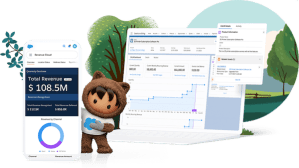There’s no doubt that 2020 has been a year to remember – and in many ways, one to forget. But while the crises and shifts of the past twelve months have presented challenges for many businesses, they have given others the opportunity to transform, evolve, and even grow their revenue.
In the new and unpredictable environment that has emerged from the upheaval of 2020, adaptability is key. Today’s B2B buyers want the kind of frictionless service they’ve come to expect on B2C channels: lightning-fast service, efficient billing, knowledgeable sales support across every touchpoint, and comprehensive information on products – all accessible with a single click.
They also want more flexible product offerings tailored to an uncertain economic climate, such as pay-as-you-go options.
What is Revenue Cloud?
To support organisations as they chart a path through the New Normal and beyond, we recently announced the launch of Revenue Cloud at the recent Dreamforce To You virtual conference.
Revenue Cloud is a powerful suite of products that connect sales, operations and finance teams to enable customer lifecycle management, from the moment of purchase right through to renewals, subscriptions and recurring revenue. By providing a single source of truth across multiple channels, Revenue Cloud allows businesses to take control of their revenue – and opens up a range of exciting possibilities, from AI-driven insights to the automation of processes.
Not every business will need to take advantage of every feature, but Revenue Cloud is flexible and scalable enough to adapt to what an organisation requires to evolve and grow. Whether it’s quickly bringing a Minimal Viable Product online by using ready-made templates and workflows, or reimagining revenue processes from the bottom up through apps such as DocuSign and GoCardless, Revenue Cloud can help businesses meet customer needs at every stage of the buying cycle.
How can businesses use Revenue Cloud?
1. Transform buying experiences
As part of Salesforce 360, Revenue Cloud is focused squarely on the needs of the customer: what they want, how to engage them, and how best to meet their needs. By allowing businesses to connect various sales channels – such as direct sales, partners, and online – Revenue Cloud powers seamless B2B experiences, so that if buyers want to start a transaction on one channel and then switch to another, they can. Revenue Cloud is powered by a flexible “configure, price, quote” solution that can be rolled out to sales reps, or integrated into online channels using a brand-new connector.
2. Bring new revenue streams online – fast
Setting up a new revenue model such as a subscription or consumption-based pricing can be slow and time-consuming, adding layers of complexity to existing systems. With Revenue Cloud, there’s no need to construct each element individually; just use the built-in billing engine, combined with the unified product catalogue, to add a new revenue stream easily and simply. Even industries that operate according to specific workflows, such as media or telecommunications, can take advantage of this simple solution, with new tools like Vlocity providing industry-specific solutions to quickly bring new revenue streams online.
3. Optimise performance
Whether your business is enjoying a period of growth or is struggling to stabilise amid the headwinds of the past year, Revenue Cloud can help to make processes more intuitive and efficient across the revenue lifecycle. When you have a birds-eye view of everything from orders to invoicing, along with real-time access to key KPIs, it’s easy to identify ways to improve, simplify or automate processes. Revenue Cloud won’t replace your ERP system, but it will complement it, making it work more effectively to generate actionable data and drive customer engagement.
How Cisco Succeeded with Revenue Cloud
When famously customer-centric Cisco wanted to re-imagine their customer experience to include new offerings and more flexible purchasing options, they turned to Salesforce and Revenue Cloud. In order to provide a frictionless journey for buyers, they used automation to streamline their processes and optimise the deployment of resources. By putting the customer at the heart of its strategy – and then bringing that strategy to life with Revenue Cloud – Cisco has seen its business boom. They’re now sending quotes, resolving problems, meeting challenges and launching products faster than ever before.
Get connected with Revenue Cloud
Revenue Cloud is already helping to make businesses like Cisco stronger and faster – and we’re just scratching the surface of its potential. New innovations will be rolled out in February, including multi-cloud billing support, customer asset lifecycle management, and the new CPQ and B2B connector. For Revenue Cloud and its B2B partners, the future looks bright.
To see an animated demo of Revenue Cloud in action, click here. And to read some of the latest insights from sales leaders around the world, check out the State of Sales report.









